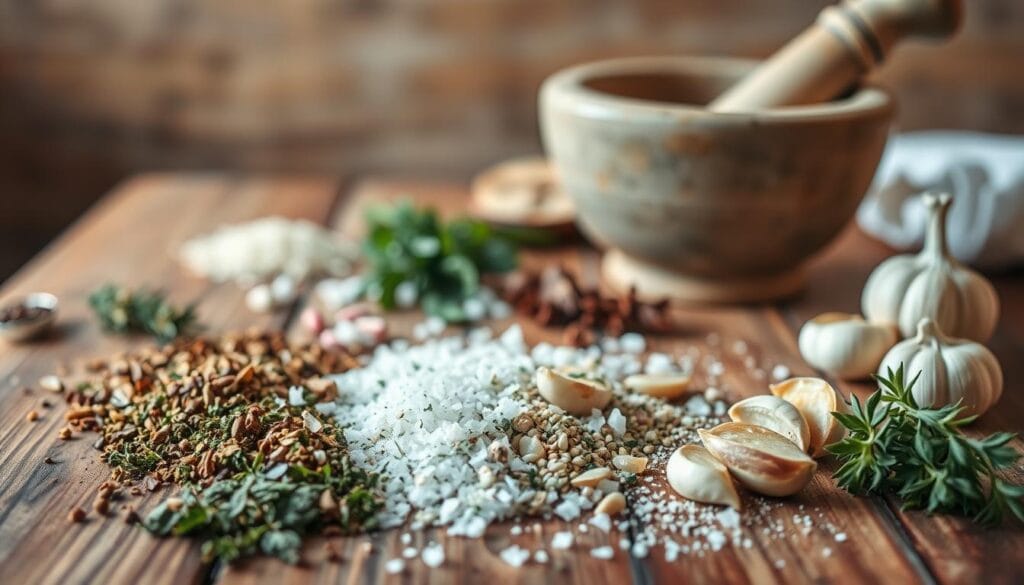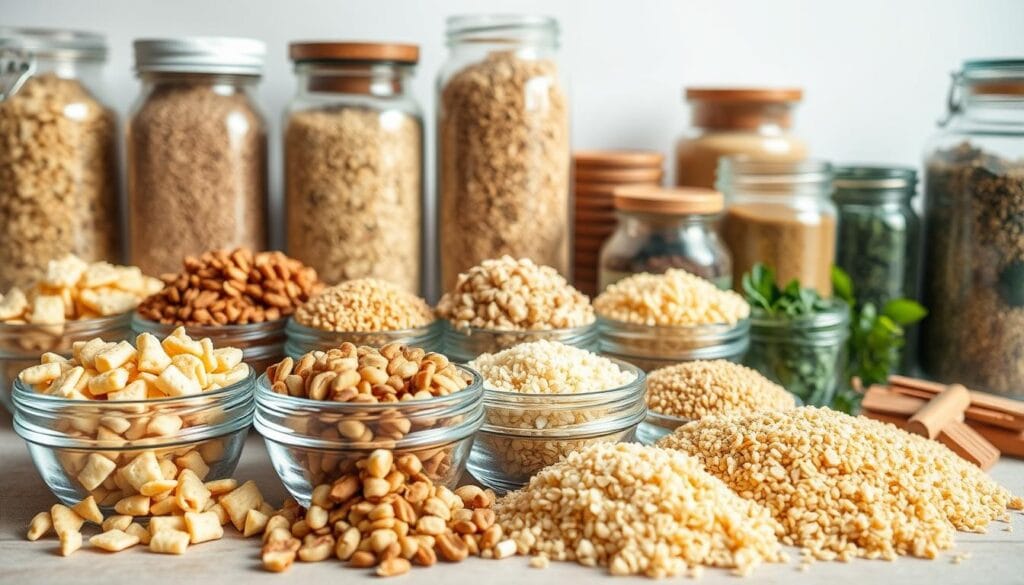Bread and crumbs
Table of Contents
Bread and crumbs are true culinary wonders. They turn simple dishes into amazing meals. add texture, fla vor, and depth to many recipes.
They’re great for making crispy chicken cutlets, a crunchy mac and cheese topping, or a golden casserole crust. Breadcrumbs bring versatility and excitement to cooking. They help bind, coat, and enhance dishes, making them a must-have in your pantry.
Learning about bread and crumbs can boost your cooking skills. You can make restaurant-quality meals at home. From traditional to panko, these ingredients offer endless creative possibilities.
Key Takeaways
- Breadcrumbs are a flexible ingredient in various cuisines
- They can enhance texture and flavor in multiple dishes
- Multiple types of breadcrumbs exist for different cooking needs
- Easy to make and store at home
- Essential for creating crispy, golden coatings
Understanding Different Types of BreadCrumbs
can make your cooking amazing. They add crunch to chicken or texture to casseroles. Knowing the types of breadcrumbs can improve your cooking.
Fresh vs. Dried Bread Crumbs
You can make it fresh or dried. Fresh ones are soft and moist, great for dishes needing a light touch. Dried breadcrumbs are crisp and add a strong crunch.
- Fresh breadcrumbs: Soft texture, ideal for binding
- Dried breadcrumbs: Crispy, perfect for coating
Panko vs. Traditional Bread Crumbs
Panko breadcrumbs come from Japanese cooking and are now popular in the West. They are lighter and airier, making a crispy coating. Made from crustless white bread, they are flaky and large.
| Characteristic | Panko | Traditional |
|---|---|---|
| Texture | Light, flaky | Dense, fine |
| Origin | Japanese | Western |
| Coating Ability | Extra crispy | Standard crispness |
Whole Wheat vs. White Bread Crumbs
The bread type changes the breadcrumbs’ nutrition and taste. Whole wheat crumbs have more fiber and nutrients. White breadcrumbs have a milder taste and look lighter, fitting many recipes.
Nutritional Benefits of Bread and Crumbs
Exploring bread recipes can change how you cook. Bread crumbs are more than just a coating. They’re full of nutrients that help keep you healthy.
Whole wheat bread crumbs are a nutritional powerhouse. A single serving gives you important nutrients for your health:
- 3g of protein per serving
- 1g of dietary fiber
- 8% daily value of iron
- 2% daily value of calcium
Sourdough bread crumbs offer even more benefits. The fermentation process makes nutrients easier to absorb. They’re great for those looking for complex carbs and probiotics.
Bread crumbs are also good for you because they:
- Are low in saturated fat
- Have moderate sodium
- Provide quick energy
- Are versatile in many dishes
The 2020-2025 Dietary Guidelines suggest eating 3-5 whole grain servings a day. Bread crumbs are a tasty way to meet this goal. They’re perfect for crispy chicken or hearty meatloaf.
Essential Kitchen Tools for Making Homemade Breadcrumbs
To make tasty homemade bread crumbs, you need some key kitchen tools. These tools turn stale bread into a great cooking ingredient. Start your breadmaking journey by knowing the right tools for crispy, flavorful bread crumbs.
When making homemade bread crumbs, picking the right equipment is key. It ensures your bread crumbs are consistent in texture and full of flavor. Here are the essential tools you’ll need:
Food Processors and Blenders
Food processors and blenders are your go-to tools for uniform bread crumbs. They make quick work of achieving the perfect consistency. When making bread crumbs:
- Remove bread crusts for finer texture
- Pulse bread in batches depending on processor capacity
- Aim for consistent, even-sized crumbs
Storage Containers and Methods
Storing your homemade bread crumbs properly is vital. Choose airtight containers to keep them fresh and dry.
- Store at room temperature for up to 1 week
- Refrigerate for up to 3 weeks
- Freeze for long-term storage up to 3 months
Drying Equipment Options
To get crisp you need good drying methods. Here are some ways to dry your bread crumbs:
- Oven drying at 300°F for 5 minutes
- Lower temperature of 275°F for 15-20 minutes
- Skillet toasting on medium heat until golden
With these essential kitchen tools, you’re ready to make delicious homemade bread crumbs. They’ll take your cooking and baking to the next level.
Popular Culinary Applications
Breadcrumbs are a kitchen superhero with incredible versatility. They can turn simple dishes into amazing culinary creations. Whether you’re making bread recipes or cooking, these tiny morsels are key.
In the world of cooking, breadcrumbs have many uses:
- Coating for crispy fried foods
- Binding agent in meatballs and veggie burgers
- Crunchy topping for casseroles
- Thickener for sauces and soups
Creating delicious croutons is another great way to use leftover bread. Cut day-old bread into cubes and toss with olive oil and seasonings. This makes golden, crunchy additions to salads and soups.
| Culinary Application | Key Benefits |
|---|---|
| Fried Food Coating | Creates crispy exterior |
| Meatball Binding | Improves texture and moisture |
| Casserole Topping | Adds crunch and visual appeal |
| Sauce Thickening | Enhances consistency |
Pro tip: For the best results, use panko breadcrumbs. They offer a light, crispy texture that traditional breadcrumbs can’t match. This is especially true in bread recipes.
Creative Coating Techniques for Crispy Results
Learning how to coat with breadcrumbs can change your baking and cooking. It makes chicken, fish, or veggies crispy and golden. The right method is key.
Standard Breading Procedure
The classic three-step breading method is the best for crispiness. Here’s how to get restaurant-quality results:
- Dredge your protein or vegetable in seasoned flour
- Dip into a beaten egg wash
- Coat thoroughly with breadcrumbs
Alternative Coating Methods
Try new things with your baking and breadcrumbs. Here are some unique coating ideas:
- Use mustard instead of egg wash for tangy flavor
- Mix breadcrumbs with grated Parmesan cheese
- Add crushed nuts for extra crunch
Temperature Control Tips
Controlling temperature is key for crispy food. When frying, keep oil at 350-375°F. For baking, preheat to 425°F for even browning.
Pro tip: Use a digital thermometer to check the internal temperature. Chicken should be 165°F for safety.
Seasoning and Flavoring Options

Turning bread crumbs into something special can change your cooking game. Whether you use artisan bread or regular loaves, the right seasoning can make a big difference. It can turn simple dishes into something truly amazing.
When seasoning bread crumbs, think about different flavors:
- Classic Italian blend with dried basil, oregano, and garlic powder
- Spicy Cajun mix featuring cayenne pepper and paprika
- Herbs de Provence with lavender, thyme, and rosemary
- Mediterranean-inspired with sun-dried tomato and parmesan
Here are some tips to get the best flavor:
- Use 1/4 teaspoon of dried spices per cup of bread crumbs
- Toast seasoned crumbs at 350°F for 8-12 minutes to enhance flavor
- Store seasoned crumbs in an airtight container for up to 6 months
“The secret to great bread recipes is understanding how to layer flavors” – Culinary Chef
Trying artisan bread can add special flavors to your bread crumbs. Sourdough or herb-infused loaves can give your crumbs a unique taste.
Remember, it’s all about balance. Start with a little seasoning and adjust as needed. Your homemade seasoned bread crumbs will be a go-to in your kitchen. They’ll make any meal special.
Storage Tips and Shelf Life Guidelines
Learning how to store your homemade bread and crumbs is key. It helps keep them fresh and tasty. The right storage keeps their texture and flavor just right.
Storing bread and crumbs right is important. It helps them last longer. Different ways to store them can keep your bread fresh and crumbs crunchy.
Proper Storage Conditions
Here are some tips for storing bread and crumbs well:
- Store bread crumbs in an airtight container
- Keep at room temperature (68-72°F)
- Avoid humid environments
- Use clean, dry containers
Signs of Spoilage
Look out for these signs that your bread or crumbs have spoiled:
- Visible mold growth
- Unusual odor
- Discoloration
- Stale or rancid smell
Freezing Methods
Freezing is a great way to keep your homemade bread and crumbs fresh. Here’s how to freeze them right:
- Wrap bread tightly in plastic wrap or freezer bag
- Remove as much air as possible
- Label with date of freezing
- Freeze for up to six months
Pro tip: Freeze bread crumbs in small portions for easy use later. Thaw at room temperature and use within a week for the best taste.
Common Substitutes and Alternatives

Need a crouton or bread crumb substitute? You have many options. These alternatives are great for those with dietary restrictions or when you’re out of traditional ingredients.
Gluten-free options are perfect for certain diets. Here are some great choices:
- Ground nuts
- Crushed gluten-free cereals
- Almond flour
- Rice crumbs
- Quinoa crumbs
Looking for something to bind or coat? Try these:
- Crackers: Crush pretzels or saltine crackers for a crispy texture
- Cornflakes: Add a nice crunch to your dishes
- Rolled oats: Great for meatloaf and more
Each substitute has its own benefits. Crushed nuts add a rich flavor, while gluten-free cereals keep things light. Choose wisely based on your recipe’s needs for the best results.
Pro tip: Always check labels for gluten, especially in cereals. Your ideal crouton substitute might be hiding in your pantry!
Conclusion
Exploring bread and crumbs opens up a world of creativity in the kitchen. Learning to make bread and bread crumbs lets you turn simple things into amazing dishes. It’s fun to use old bread to make new, tasty crumbs.
Homemade bread crumbs are good for the planet too. They cut down on carbon emissions from factory-made products. You get cleaner ingredients, less preservatives, and a greener way to cook. Plus, freezing them keeps them fresh for when you need them.
There are many ways to make bread, each with its own taste. You can try making sourdough or whole wheat bread. Adding herbs, spices, and cheeses to your crumbs makes any dish special.
Your adventure with bread and crumbs is about being creative and resourceful. Homemade crumbs are great for coating meats, adding crunch to casseroles, or making crispy toppings. They let you express your cooking style in new and exciting ways.
Share Your Creation!
I’d love to see how your Bread and crumbs turns out! If you make this recipe, please leave a comment and rating below. You can also share your creation by tagging me on pinterest @bake_iteasy with the hashtag #Bread and crumbs.
FAQ
What exactly are bread crumbs?
What’s the difference between fresh and dried bread crumbs?
What makes panko bread crumbs unique?
Are whole wheat bread crumbs healthier than white bread crumbs?
How can I make homemade bread crumbs?
What are the best ways to use bread crumbs in cooking?
How do I create a perfect crispy coating with bread crumbs?
How should I store bread crumbs?
Are there gluten-free alternatives to traditional bread crumbs?
Can I flavor my own bread crumbs?
Did you try our recipe ?
There are no reviews yet. Be the first one to write one.







